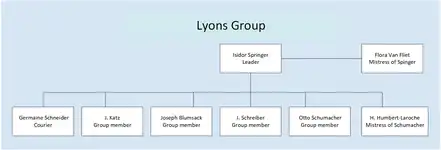Isidore Springer
Isidore Springer (23 July 1912 in Antwerp, 27 December 1942 in Lyon, France) was Belgian diamond dealer and communist[1] who became an important member of the Red Orchestra organisation in Belgium and later France during World War II.[2][3] Springer worked as a recruiter and courier between Leopold Trepper, a Soviet agent who was the technical director of Soviet espionage in Western Europe, and Anatoly Gurevich, also a Soviet agent, in Belgium.[4] He would later run the 6th network of Trepper's seven espionage networks in France, providing intelligence from US and Belgian diplomats.[5] His aliases were Romeo, Verlaine, Walter van Vliet, Fred and Sabor.[2]
Life


Springer's father was Simon Springer and his mother was Lona Kunstlinger Springer.[2] His mistress was Rita Arnould.[2]
Career
Between 1930 and 1931, Springer lived in Paris. According to Willy Berg, the member of the Sonderkommando Rote Kapelle who interrogated Springer after he was arrested, worked for Trepper before the outbreak of World War II, liaising with the Soviet Embassy when Trepper was away.[2]
In 1938, Springer moved to Belgium and became an active member of the espionage network run by Anatoly Gurevich.[2] Springer fought against fascist forces in Spain from 1937-1938. Springer ran the 6th network of Trepper's 7 networks in Europe, supplying intelligence garnered from US and Belgian diplomats.[6] He was also as a recruiter and a courier between Gurevich in Brussels and Trepper in Paris.[2] After the raid at 101 Rue des Atrébates by the Funkabwehr on 12 December 1941, Mikhail Makarov was arrested, Springer fled to Paris with Gurevich on 15 December 1941.[2] Springer was sent to Lyon by Trepper where he attempted to establish a new espionage network. However, Springer failed to establish a wireless telegraphy link with Moscow.[2]
Arrest and death
Springer was arrested on 19 December 1942 and sent to Fresnes Prison. He committed suicide on 24 December 1942.[7]
References
- Trepper, Leopold (1977). The great game : memoirs of the spy Hitler couldn't silence. New York: McGraw-Hill. p. 119. ISBN 9780070651463. OCLC 2091569.
- Kesaris, Paul. L, ed. (1979). The Rote Kapelle: the CIA's history of Soviet intelligence and espionage networks in Western Europe, 1936-1945. Washington DC: University Publications of America. p. 359. ISBN 0-89093-203-4.
- Perrault, Gilles (1969). The Red Orchestra. New York: Schocken Books. p. 100. ISBN 0805209522.
- Gotovitch, José (1992). Du rouge au tricolore : les communistes belges de 1939 à 1944 : un aspect de l'histoire de la Résistance en Belgique [From red to tricolor: the Belgian communists from 1939 to 1944: an aspect of the history of resistance in Belgium]. Archives du futur (in French). Brussels: Editions Labor. p. 561. ISBN 9782804006426. OCLC 26447788.
- Kesaris, Paul. L, ed. (1979). The Rote Kapelle: the CIA's history of Soviet intelligence and espionage networks in Western Europe, 1936-1945. Washington DC: University Publications of America. p. 90. ISBN 0-89093-203-4.
- Kesaris, Paul. L, ed. (1979). The Rote Kapelle: the CIA's history of Soviet intelligence and espionage networks in Western Europe, 1936-1945. Washington DC: University Publications of America. p. 90. ISBN 0-89093-203-4.
- Trepper, Leopold (1977). The great game : memoirs of the spy Hitler couldn't silence. New York: McGraw-Hill. p. 432. ISBN 9780070651463. OCLC 2091569.